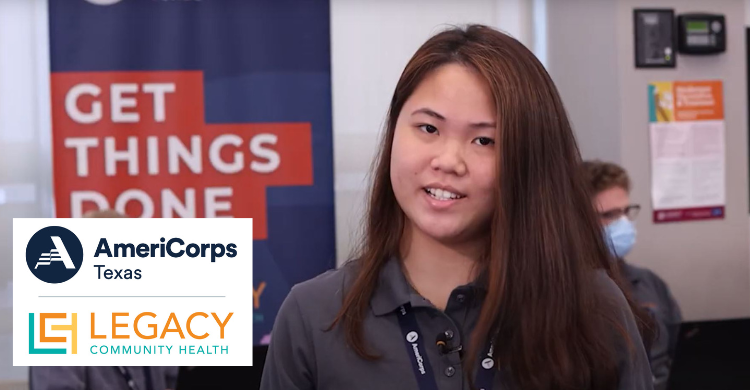As a child, Boi Ha always dreamed of becoming a superhero, helping those in need. Now as AmeriCorps Program Coordinator at Legacy Community Health, the cape she wears may not be visible, but the impact she has made is undeniably heroic.
Boi isn’t fighting this battle alone, she has a dedicated team of AmeriCorps members working alongside her. Through AmeriCorps, Legacy has become a second home for Boi, a place where she and her colleagues are committed to getting things done.
Legacy predominantly serves the Hispanic population and it’s Boi’s responsibility to assess the social determinants of health impacting patients. Being embedded in the Hispanic community was an eye-opening experience as she witnessed patients’ resilience and perseverance as they navigate various challenges to receive basic care. These obstacles mirrored the barriers her own Chinese and Vietnamese communities face in accessing quality health care.
As Asian American Pacific Islander (AAPI) Heritage Month winds down, we asked Boi how AmeriCorps intersects with her culture and love of public health.
Q: How have your personal experiences or cultural traditions influenced your work?
One cultural value that is emphasized in many Asian cultures and can influence perspectives on community service is the concept of filial piety – showing respect and care for one’s elders and ancestors. This sense of duty and obligation to family can extend outwards to the larger community.
In Chinese traditions, there is an emphasis on harmonious relations and mutual obligations within a hierarchical society. Contributing to the greater good of your community through service and good deeds is seen as a way to cultivate virtue and maintain social harmony.
Similarly, in Vietnamese culture, the idea of “tình làng nghĩa xóm” highlights the importance of cultivating good relations and exhibiting care and compassion within one’s village or community. Acts of service allow individuals to build up moral merit and social capital.
Q: How do you include cultural understanding to build trust with the communities you serve through AmeriCorps?
Integrating cultural competence into community service involves several key practices:
- Active Listening and Empathy: Taking the time to listen and understand the unique needs and perspectives of the community members.
- Cultural Awareness Training: Engaging in ongoing education about the cultural backgrounds of the communities served to better understand their values, customs and communication styles.
- Building Relationships: Developing trust and rapport through consistent, respectful and meaningful interactions.
- Community Engagement: Involving community members in planning and decision-making processes to ensure their voices are heard and respected.
Q: How can AmeriCorps and AAPI Heritage Month intersect to enhance diversity, equity, and inclusion (DEI) in community service initiatives?
AmeriCorps and AAPI Heritage Month intersect significantly in promoting DEI within community service efforts. AAPI Heritage Month offers opportunities to highlight the contributions and cultural richness of Asian American and Pacific Islander communities. This celebration aligns with AmeriCorps’ mission to foster civic engagement and build community resilience through diverse volunteerism.
By recognizing and celebrating AAPI Heritage Month, AmeriCorps can:
- Increase Awareness and Understanding: Educate volunteers and the broader community about the history, culture, and contributions of AAPI individuals, thereby fostering a more inclusive environment.
- Promote Representation: Encourage more AAPI individuals to participate in AmeriCorps programs, ensuring diverse perspectives and experiences are represented.
- Enhance Cultural Competence: Provide training and resources that help AmeriCorps members understand and respect cultural differences, improving their ability to serve effectively in diverse communities.
Q: Can you provide examples of how AmeriCorps fosters understanding of the AAPI community among its members through their service experiences?
AmeriCorps brings together members from all walks of life to serve in different capacities and roles. This diversity allows for rich interactions that can break down stereotypes and facilitate mutual understanding.
AmeriCorps teams have members from the local AAPI community working alongside others from different ethnic backgrounds. Team-building activities, shared living spaces (for residential programs), and the simple act of working side-by-side can help forge bonds across cultures. Members learn about each other’s traditions, foods, languages, and values through these interpersonal relationships in ways textbooks cannot convey.
The Gulfton-Dashwood area in Houston has a rich, vibrant AAPI population including Vietnamese, Chinese, Pakistani and other diasporic communities. AmeriCorps members serving in this area through local organizations, schools, or community centers gain a ground-level view into the lived experiences of these groups.
They may witness firsthand some of the socioeconomic challenges facing AAPI families like poverty, limited English proficiency, access to social services, or dealing with the impacts of environmental racism. This awareness counters the “model minority” myth.
At the same time, members are immersed in the cultural strengths of these communities. They may experience the social fabric of AAPI enclave neighborhoods, attend cultural festivals and events, interact with long-standing small businesses and more. This allows for an appreciation of the vibrant diversity within the AAPI umbrella.
AmeriCorps creates spaces for both personal rapport-building across differences and an immersive, contextualized understanding of the AAPI experience – its strengths and challenges. This dual approach allows for more authentic cultural awareness.

